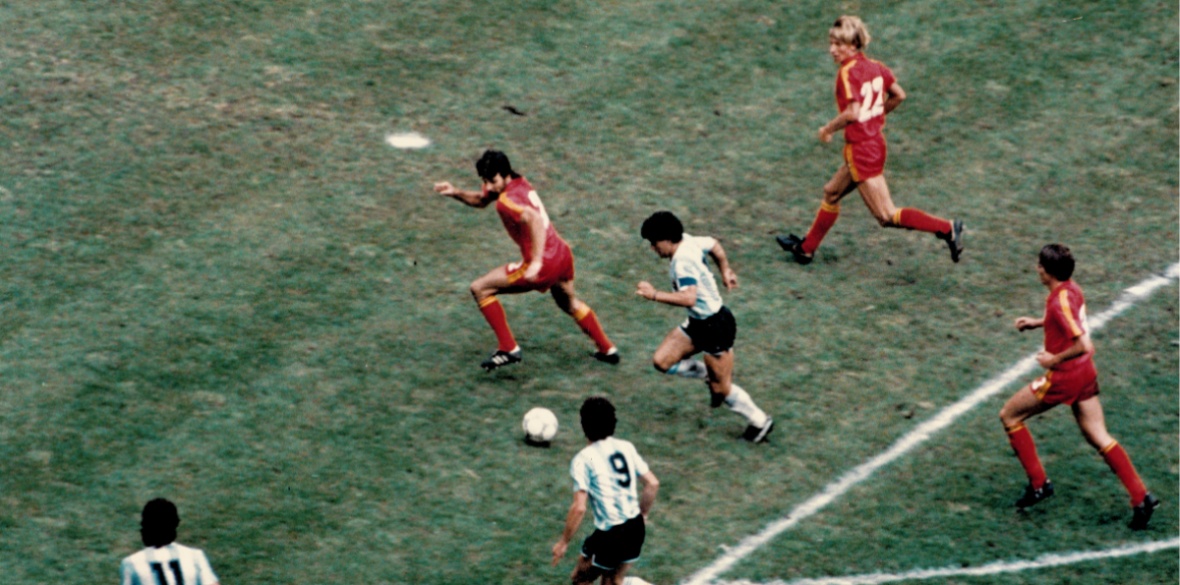This is the last article you can read this month
You can read more article this month
You can read more articles this month
Sorry your limit is up for this month
Reset on:
Please help support the Morning Star by subscribing here
EARLY in the second half of the opening match of the 1982 World Cup, Osvaldo Ardiles feigned a shot from a free kick and instead passed the ball to his 21-year-old team-mate standing beside the defensive wall.
His attempted chipped pass was comfortably cleared by the Belgium defence. A move typical of a game in which the defending world champions, Argentina, floundered during a 1-0 defeat.
During this otherwise unremarkable play, high up in the upper tier of Barcelona’s Camp Nou, a 30-year-old photographer with little experience of shooting football, had captured an image which would live in the consciousness of the sporting world far longer than the result of the game and even outlive the subject of the picture, a young Diego Maradona.
Now retired, Steve Powell last year released a book on his illustrious career in photography, called The Image Business: Get The Picture, Tell The Story.
Part of a collage front cover, one picture is front and centre, the one Powell devotes a chapter to in his book and the one he refers to “that photo.”
The picture shows Maradona controlling the ball as the six-man Belgian wall spin round and scatter to face him.
An inconsequential, fleeting moment in a forgettable game came to symbolise everything people saw in Maradona, one extraordinary man capable of taking on a whole team.
Speaking to me about the picture 40 years on, Powell told me he didn’t think it was a conscious decision to shoot the camera at that point.
“Essentially, there was this shape forming and I took a picture,” Powell said. “It was just the one frame. It was very lucky.”
Part of the Allsport Photographic agency he created, Powell was at the match freelancing for Sports Illustrated. The junior member of a three-man team, the other two cameramen had picked the prime locations behind each goal.
Powell was left to take up a public seat in the stands to capture the dignitaries in attendance for the opening ceremony.
“The primary reason I was there was because there was something going on in the president’s box. I thought I might be able to get a picture of it.”
Powell’s image of Maradona was not considered relevant for the Sports Illustrated World Cup spread. Had they published it, they would have claimed the rights to it.
Instead, as part of Allsport’s “use or return” arrangement, the copyright passed back to Powell and the agency’s library of stock images.
It was not until many weeks later that Powell, going through his unused images realised the potential of the photograph, filing it away with a red dot.
“What struck me the most was the graphic image itself, the colours of the green grass, the orange-red of Belgium’s shirts. The contrast between Maradona wearing blue, with his dark hair, the sheer balance of him. He is absolutely on his toes, anticipating the next move.
“I doubt it would have been as visually powerful had Belgium been playing in a different colour.
“By today’s standards, because it was an evening match, the quality of the original is not the greatest. It’s not important really. If it had been on a modern digital camera, it would have been a totally different picture.”
Over the years, the photograph sold regularly as a stock image of Maradona and gained impetus four years later when he inspired Argentina to win the next World Cup in Mexico.
In the semi-final against Belgium, Maradona delivered on the promise suggested in the photograph by scoring a decisive second goal after scorching past three defenders.
“The significance of the photograph became more and more obvious as Maradona’s reputation escalated,” Powell said.
“It’s more about telling a story about the man than a moment in football.”
When Maradona died in November 2020, the outpouring of grief on social media left people yearning to capture the essence of one man’s genius and demonstrate his place within the sporting firmament.
Many turned to Powell’s photo, now owned by Getty Images who bought Allsport’s back catalogue in 1998.
During a long career, Powell captured many images which have passed into sporting folklore. One such is the photo of all-conquering decathlete Daley Thompson crossing the finishing line in the 1982 European Championships.
In it Daley stands triumphant as his vanquished competitors lie on the track
Another is the photo-finish shot of six sprinters who all ran under 10 seconds at the end of the 1991 World Athletics Championship 100m final in which Carl Lewis broke the world record.
But none of Powell’s images have achieved the global fame of the Maradona shot.
“It’s a fabulous photograph,” Powell admits. “It happened in such a fleeting moment and for it to have such a life is quite extraordinary, especially as I was not a big football photographer. I worked on ideas and stories.
“It took on its own life. It’s hard not to be proud of it.”
Many have tried to recapture the beauty of “that photo.” Even this month, a picture of Lionel Messi taking on four Italian defenders at Wembley became a popular meme on social media.
Eighteen years later, Powell was contacted by Shoot Magazine, who informed him his picture had been voted the best football photo of the century.
In 2001, Total Football magazine also nominated the picture as number one among its list of the 50 greatest football photos.
“I didn’t really have a lot to do with football,” said Powell who never worked at another World Cup. “It wasn’t my game. It wasn’t until many years later that I found out what impact that photo had had.”
“There was a lot of luck involved, the fact that I was in that position in the first place. It’s an unusual position to be high in the crowd.
“Those kinds of pictures come from concentrating all the time, following the play constantly.”
Powell believes Maradona himself was a fan of the image. “I’ve heard from several people that he had copies of the picture.
“The six Belgian players, Michael Renquin, Guy Vandersmissen, Luc Millecamps, Frankie Vercauteren, Maurits De Schrijver and Ludo Coeck have also passed into folklore, the anonymous opponents, like so many of those who faced Maradona over the years, caught like rabbits in the headlights of his radiant brilliance.”
The fact that Belgium effectively subdued Maradona in the game and won the match is often forgotten as Powell explained, “the Belgium team tried to express that it wasn’t a look of terror in their faces!”
The photo has become a piece of sporting art, displayed on the walls and consciousness of many a football fan’s gallery, including this one.
Powell, the cameraman who specialised in creating narratives through his photographs, told me “it’s an illustration of a relationship between players, more than a portrait of a player, and the power of Maradona himself.”
In his book, Powell summarises what the photo represents to him. “Ultimately it was not about the composition, not about art and not even about that particular game. It transcends all that. It’s about communication. It communicates the power of Maradona and the fear he instilled.
“It’s about this one man and the relationship he had with opposing players and, at its roots, good photography is always a matter of good communication.”









